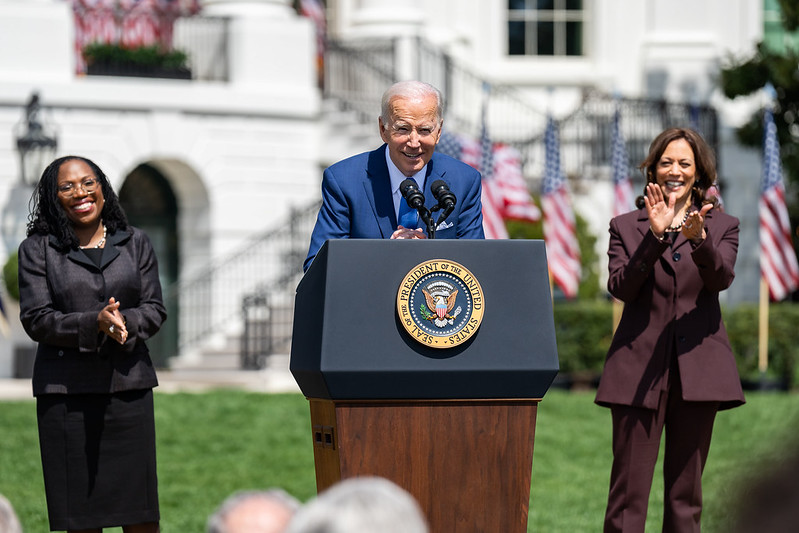
President Joe Biden, joined by Vice President Kamala Harris, delivers remarks on the confirmation of Supreme Court Justice Ketanji Brown Jackson, Friday, April 8, 2022, on the South Lawn of the White House. (Official White House Photo by Adam Schultz)
What Blacks Have Done for Themselves
Well, no, President Joe Biden didn’t actually say those words recently, but he might as well have, writes Jason L. Riley in the WSJ:
Mr. Biden proudly pointed to his “executive orders on racial equity” and his decision to appoint black people “to my Cabinet, my staff, in the judiciary and to key positions in agencies such as the Federal Reserve.” The president also mentioned “Bidenomics,” which he insisted “is working.” He didn’t tell us that some of his best friends are black, but he might as well have.
The President has a problem, according to recent polling: an increasing number of voters – black or white – are not buying his spiel. Political scientist Ray Teixeira cites data from a New York Times/Siena College survey released this month:
Mr. Biden’s “little talked about” weakness among nonwhite working-class voters, including but not limited to blacks.
Mr. Biden leads Donald Trump “by a mere 16 points among this demographic,”
Political scientist Ray Teixeira writes. “This compares to his lead over Trump of 48 points in 2020. And even that lead was a big drop-off from former President Barack Obama’s 67-point advantage in 2012.”
Mr. Riley believes now is a good time for Joe Biden to reflect on what Blacks have done for themselves.
Regardless of what Mr. Biden believes he’s done for blacks, isn’t King’s historic march a time to reflect on what blacks have done for themselves? In his new biography of the civil-rights icon, “King: a Life,” (Jonathan Eig) reminds us that President John F. Kennedy predicted that the march would be “a great mistake” and urged King to call it off. When King and other civil-rights leaders met with JFK in June 1963, the president told them that a demonstration of that size would jeopardize pending civil-rights legislation.
Birmingham in May 1963 had been a turning point for the movement. It’s where King and thousands of others were jailed for protesting Jim Crow segregation. It’s where Bull Connor, the city’s public-safety commissioner, turned fire hoses and police dogs on demonstrators, including children. A photo of a large dog lunging at a black 15-year-old boy appeared in newspapers across the country. “The photo shook the world and crystallized the message King and others had been trying for years to express,” according to Mr. Eig.
On May 10, 1963, King and his allies reached an agreement with Birmingham officials to phase out segregation.
Were he alive today, King surely would be disappointed that black-white gaps persist in income, employment, incarceration, schooling and other areas. Yet it’s hard to believe that he wouldn’t be pleased with the gains. Mr. Biden likened voting laws in Republican states to “Jim Crow 2.0,” but in recent elections black voter-registration and turnout rates have hit record highs and in some cases exceeded white rates, including in the Deep South.
Black median incomes still trail those of whites, but as economist Thomas Sowell writes in his new book, “Social Justice Fallacies,” “2020 census data show more than 9 million black Americans with higher incomes than the median incomes of white Americans.”
One reason blacks continue to lag behind whites and other groups is the failure of government efforts. Many have backfired.
Welfare-state expansions have increased dependency and subsidized counterproductive behavior. In the early 1960s, two-thirds of black children lived with a mother and a father. By the mid-1990s, it was down to one-third.
MLK would have been disappointed by this “counterproductive” behavior, notes Mr. Riley.
Perhaps, unlike a lot of black leaders today, (MLK) would be willing to talk about it.
If you’re willing to fight for Main Street America, click here to sign up for the Richardcyoung.com free weekly email.





